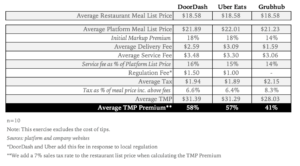Food delivery services are riding the demand rollercoaster. While the pandemic pushed the business higher, the return to normal has been jolted back to reality. Shares of DoorDash and Grubhub (now part of Just Eat Takeaway) increased by an average of 42% in 2020 and have since declined by an average of 60% from their highs. 2022 is shaping up to be a tough year for food delivery given it’s a luxury service at risk of being cut in an inflationary environment.
Beyond 2022, the long-term outlook for these companies is a function of the value these platforms provide to its users. One way to measure customer value is to better understand the incremental cost of using food delivery in comparison to pickup. That incremental cost is dependent on six variables including: restaurant meal price, platform meal price, delivery fee, service fee, regulation fee and tip.
Survey says: 82% premium, up from 79%
Every six months we do a survey of ten meals delivered across the three major platforms to measure the cost of using food delivery. Our most recent findings conclude that the average premium to use food delivery increased slightly from 79% in October 2021 to 82% today (including 20% tip). Our opinion: this is too high for mass adoption.
- Grubhub and DoorDash were tied for the cheapest. Last year, Grubhub was the cheapest.
- Food delivery is expensive, with premiums ranging from 40-45% for a ~$13 order. Including a 20% tip, the premium is closer to 82%.
- There’s a combination of hidden fees and variable pricing across delivery platforms that keep the cost of food delivery high as a percentage of the meal cost.
- While some consumers are willing to pay for the convenience factor, it’s unlikely that the current cost structure yields mass adoption.
The basics of a food delivery order
We made ten identical food orders and did a fee average across DoorDash, Uber Eats, and Grubhub from upstate New York. We then compared it to the price a consumer would pay going directly to the restaurant. The table below summarizes our findings related to the total meal price (TMP) premium. Note: this exercise includes a 20% tip to the overall order price.
 The same delivery address was used for all orders. While delivery, service, and tax fees certainly vary across the country, we believe the basic insights are applicable more broadly.
The same delivery address was used for all orders. While delivery, service, and tax fees certainly vary across the country, we believe the basic insights are applicable more broadly.
Food delivery is more expensive than you think
The first thing that stands out is the initial markup premium, which is 8-12% across the platforms. The initial markup premium is the difference between the meal price that a restaurant lists on its own website and the base price listed on the delivery app. We believe most restaurants raise menu prices on delivery apps to offset the roughly 15-20% delivery and service commissions of the platform.
Delivery fees ranged from $1.08 to $2.04 on average. Since delivery fees remain constant on orders over $10, their contribution to the total meal price varies by order size. Service fees are determined as a percentage of the platform meal list price, usually around 15%. This means that the dollar amount paid in service fees increases as the order size grows.
While it’s not explicitly stated when the sales tax is applied, we think it’s applied after delivery, service and regulation fees have been added. This implies average tax rates of ~7%.
It’s worth noting that the overall premium increase from Fall to Spring 2022 (79% to 82%) was the result of a higher delivery fee offset by the elimination of a regulation fee, applied by DoorDash and Uber, to circumvent capped service fees of 15% during the peak of the pandemic. The effort to cap service charges on delivery platforms was driven by concerns that consumers were being overcharged.
Time is money
In terms of cost of delivery, we found the markups to be egregious. That said, with food delivery, consumers are buying time. All said and done, we estimate that it typically takes 30 minutes to drive and pick up a meal. Factoring in a 50% delivery premium on a $20 order means the customer is valuing their leisure time at $20/hour. Typically, people value leisure time over work time. In other words, delivery is expensive but worth it for “time is money” consumers.
Disclaimer
